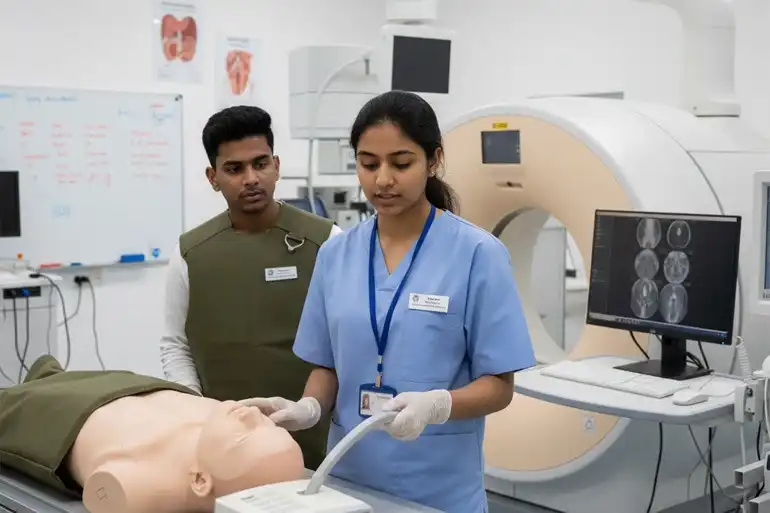Latest Notifications

Blog

B.Sc. in Radiology & Imaging Technology: What You Need to Know Before Enrolling
Choosing the right course for your undergraduate studies is a big step, especially in a field as dynamic and vital as healthcare. If you're a science student looking for a rewarding career that blends technology, science, and patient care, the B.Sc. in Radiology & Imaging Technology program in West Bengal might be the right fit for you.
What is B.Sc. in Radiology & Imaging Technology?
The B.Sc. in Radiology & Imaging Technology is a four-year undergraduate program that focuses on the science and technology used to create internal images of the human body for medical purposes. These images are crucial for diagnosing diseases, monitoring treatment effectiveness, and guiding various medical procedures. The field of radiology is at the forefront of modern medicine, acting as the eyes of doctors. Without accurate diagnostic images, it would be difficult to identify many health conditions. The professionals who operate the sophisticated equipment to produce these images are known as radiographers or radiology technologists. The B.Sc. program trains students to become these skilled professionals.
Curriculum: The Foundation of Expertise
A strong curriculum is the backbone of any good academic program. The B.Sc. in Radiology & Imaging Technology is structured to provide a blend of theoretical knowledge and practical, hands-on training. This ensures that graduates are not only well-versed in the concepts but are also competent in applying them in a clinical setting.
The core subjects typically include:
Human Anatomy & Physiology:
Understanding the structure and function of the human body is fundamental. This knowledge helps in correctly positioning patients and interpreting the resulting images.
Physics of Imaging:
This covers the principles of radiation physics, which is the basis for technologies like X-rays, CT scans, and nuclear medicine. Students learn about radiation safety and how different energy sources interact with the body.
Radiography and Image Processing:
This is the practical side of the course. Students learn to operate various imaging machines and process the images they produce.
Specialized Modalities:
The curriculum delves into advanced imaging techniques, including:
Computed Tomography (CT):
A technique that uses X-rays to create cross-sectional images.
Magnetic Resonance Imaging (MRI):
This uses magnetic fields and radio waves to generate detailed images of organs and soft tissues.
Ultrasound (Sonography):
A method that uses high-frequency sound waves to create real-time images.
Nuclear Medicine:
This involves using small amounts of radioactive material to diagnose and treat diseases.
Patient Care and Ethics:
The course also emphasizes the importance of patient communication, comfort, and safety. Ethical considerations and adherence to medical laws are also covered.
Haldia Institute of Health Sciences has a curriculum that is designed to meet the industry's evolving needs. The institute’s focus on practical application and clinical exposure ensures that students gain real-world experience, which is essential for a successful career in this field.
Career Opportunities: A World of Possibilities
A B.Sc. in Radiology & Imaging Technology opens up a variety of rewarding career paths. The demand for skilled professionals in this field is high, both in India and abroad, due to the continuous growth of the healthcare sector. Graduates can work in various settings, including hospitals, diagnostic centers, research institutions, and even medical equipment companies.
Some of the key job roles include:
Radiographer / Radiologic Technologist:
This is the most common role. A radiographer operates X-ray machines, CT scanners, and other imaging equipment to produce diagnostic images.
MRI Technologist:
Specializes in operating MRI machines and preparing patients for scans.
Ultrasound Technologist (Sonographer):
Performs ultrasound examinations, which are commonly used in obstetrics and for imaging soft tissues and organs.
CT Scan Technologist:
Focuses on conducting CT scans for detailed cross-sectional images.
Radiation Safety Officer:
Ensures that all radiological procedures are conducted safely and in compliance with regulations.
Application Specialist:
Works for medical equipment manufacturing companies, providing training and technical support to healthcare professionals on new imaging technologies.
Academician/Instructor:
With further studies and experience, you can pursue a career in teaching and training the next generation of professionals.
Beyond these roles, many graduates also opt for higher education, such as an M.Sc. in Medical Imaging Technology or related fields, to specialize and advance their careers.
Benefits of Pursuing This Course
Choosing a B.Sc. in Radiology & Imaging Technology comes with several significant benefits:
High Demand and Job Security:
The healthcare sector is growing, and diagnostic imaging is a fundamental part of modern medicine. This ensures a steady demand for qualified professionals and offers good job stability.
Direct Impact on Patient Care:
As a radiology technologist, you play a direct and crucial role in the diagnostic process. Your work helps doctors accurately identify health issues, which can lead to life-saving treatments.
Technological Advancement:
The field is constantly evolving with new technologies. This means a career in radiology is dynamic and offers opportunities for continuous learning and skill development.
Diverse Work Environments:
You are not limited to working in a single type of institution. Opportunities are available in hospitals, private clinics, diagnostic labs, and research centers.
Respected Profession:
Medical imaging professionals are a vital part of the healthcare team. Their expertise is highly valued and respected by doctors and patients alike.
Why Choose Haldia Institute of Health Sciences?
The B.Sc. in Radiology & Imaging Technology in West Bengal program requires a strong academic foundation and extensive practical exposure. Haldia Institute of Health Sciences (HIHS) has established itself as a reputable institution in this field. The institute’s commitment to providing a balanced curriculum and hands-on training sets it apart.
Experienced Faculty:
The faculty at HIHS comprises experienced professionals and educators who guide students through both the theoretical and practical aspects of the course.
Modern Infrastructure:
The institute is equipped with labs and facilities that simulate real-world clinical environments, allowing students to get hands-on experience with modern imaging equipment.
Clinical Training:
HIHS places a strong emphasis on clinical training. Students get opportunities to work in a supervised setting, gaining experience in patient handling, procedure execution, and professional communication.
Choosing the right institution is as important as choosing the right course. A good college not only imparts knowledge but also shapes a professional’s skills and ethical values.
Frequently Asked Questions (FAQs)
Q1: What is the eligibility criteria for the B.Sc. in Radiology & Imaging Technology course?
A1: Candidates must have completed their 10+2 with a science stream, including Physics, Chemistry, and Biology, from a recognized board. Specific percentage requirements may vary, so it is best to check with the admissions department of the institute.
Q2: Is the course duration four years?
A2: Yes, the B.Sc. in Radiology & Imaging Technology is a four-year undergraduate degree program.
Q3: What is the difference between a Radiologist and a Radiographer?
A3: A Radiologist is a medical doctor who has completed an MD in Radiology. They are responsible for interpreting the images produced by a radiographer and providing a diagnosis. A Radiographer is a technologist who operates the imaging equipment to create the images. They work under the supervision of a radiologist.
Q4: What are the opportunities for further studies after B.Sc. in Radiology & Imaging Technology?
A5: You can pursue a Master of Science (M.Sc.) in Medical Imaging Technology, M.Sc. in Nuclear Medicine Technology, or other specialized courses to enhance your expertise and career prospects.
Conclusion
The B.Sc. in Radiology & Imaging Technology is a rewarding and stable career choice for those interested in the nexus of healthcare and technology. It offers an opportunity to be an essential part of the medical community, contributing directly to patient diagnosis and treatment. With its demand for skilled professionals and continuous advancements, this field holds a promising future. For an institution that provides the comprehensive training needed to excel in this field, consider Haldia Institute of Health Sciences.
Contact Us
For more information on the B.Sc. in Radiology & Imaging Technology program at Haldia Institute of Health Sciences, please visit our official website or contact our admissions office.

